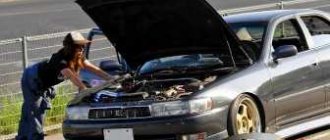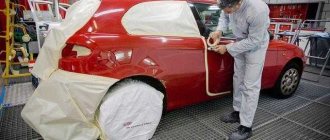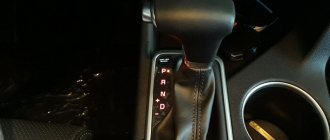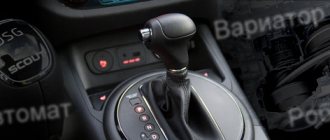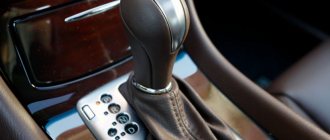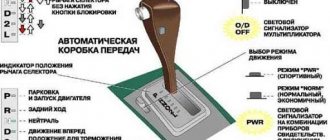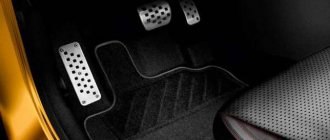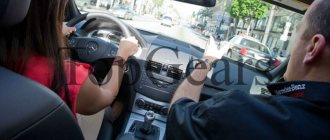The question of whether it is possible to start a car with an automatic transmission from a pushrod becomes relevant every time a car with an automatic transmission seizes and the battery does not charge or the starter fails. Manuals for many cars state that this cannot be done, but the situation is not so clear-cut. The answer to the question whether it is possible to start an automatic transmission from a pusher depends on the type of automatic transmission and the subtleties of its design.
Therefore, in most cases, it will not be possible to start a car with an automatic transmission from a tow the same way as with a manual one. But if your model is one of the exceptions, starting the engine from a pusher is quite feasible.
Types of automatic transmissions and their features
Some motorists think that manufacturers are playing it safe by prohibiting them, but this is not the case. To understand why it is impossible to start an automatic machine from a pusher, as well as how to do this in exceptional cases, you need to delve a little into the theory.
How to start a machine gun from a pusher: the theoretical part
How to push start a car with different types of automatic transmission
A prerequisite for starting a car engine from a tow is the presence of a rigid connection with the wheels. On a manual transmission, the crankshaft is connected to the input shaft through a friction clutch disc, and the drive shaft to the driven shaft (and this to the wheels) through gears connected by clutches. Different types of automatic transmissions do not have this tight linkage for various reasons described below.
Torque converter automatic
A classic hydraulic automatic transmission is connected to the engine not by a friction clutch, but by a torque converter (donut). In it, rotation is transmitted to the input (primary) shaft of the gearbox due to the pressure of the oil flow created by the drive impeller and acting on the driven impeller. In order for the motor to form a connection with the shaft, it must gain speed above idle. This is the first reason why the automatic machine cannot be started from a tow.
Torque converter design diagram
Gear shifting in an automatic transmission occurs not through rigid mechanical rods, but through hydraulic mechanisms. For the speed to turn on, the oil (ATF) in the box must be under pressure. And the pressure there is created by a pump on the input shaft, spun by the motor. While there is no pressure, the gear clutches are disengaged and the output (secondary) shaft, which transmits rotation to the wheels, is in no way connected with the primary one.
That is, no matter how the secondary shaft rotates from the wheels, the pump on the primary one will not be able to spin up, and there will be no pressure to turn on the speed. And if there is no gear engaged, there will be no transmission of rotation along the chain “secondary shaft – transmission gears – input shaft – donut – crankshaft.” That is why the answer to the question whether an automatic transmission can be started from a pusher is usually negative.
Robotic gearbox
A robotic gearbox (manual transmission) is an evolution of a conventional manual transmission, in which gear shifting is carried out not by the driver through a lever, but by a computer through servos. Therefore, theoretically, it is possible to start a car from a pusher using such an automatic machine. But in practice this is difficult to implement, since the servo drive must receive a command to engage the gear. And without the engine running, he can do this only on cars where emergency starting from a tug is provided by the developers, as well as on manual transmissions of early generations. Therefore, it is not always possible to start such an automatic machine from a pusher.
Variable speed drive
A variator (CVT) is a continuously variable automatic transmission that is connected to the engine through the same torque converter (donut) or a set of clutches (automatic clutch). The gear ratio in it changes due to changes in the diameter of the cone pulleys, drive and driven. The leader is connected to the motor, the slave is connected to the wheels. The diameter of the pulleys, like the gear ratios in a classic automatic transmission, changes under oil pressure. If it is not there, the belt may slip on the pulleys, and as a result, the box will quickly fail. So the variator is an almost 100% guarantee that it is impossible to start from a pusher.
Cases when you can start a machine gun from a pusher
In some cases, the answer to the question whether it is possible to start an automatic car from a pushrod will be YES. But this is most likely an exception to the rule. You can start a car automatically from a pusher if we are talking about some older models:
Automatic robotic gearbox lever. The ability to start an automatic transmission from a tug depends not on its functionality, but on the device
- Mercedes-Benz W124, W126, W140, W460, W463 and other models with automatic transmission models 722.3 and 722.4;
- some American cars from the 80s and 90s;
- some old Japanese ones, like Mitsubishi, Toyota up to the 90s.
The general condition that allows you to start an automatic transmission from a pusher in the above cases is the presence of a second oil pump as part of the box . Unlike the main one, usually located on the input shaft side, it is located in the tail and is connected to the output shaft. If such a pump is available, then when the car is towed, it is driven by the wheels and is capable of creating pressure that is sufficient to turn on the speed.
Another example of an automatic machine that can be started from a pusher is the Lada AMT 2182. This is a “robot”, which in general terms is similar to the VAZ mechanics (known since the days of “chisels”), but has servos. Engineers have provided for the possibility of its emergency launch.
What is push launch?
To start an internal combustion engine you need four things: spark, air, fuel and compression. Nowadays all these parameters are controlled by the on-board computer, but previously, on older cars, the spark and fuel supply were mechanically linked to the rotation of the engine. But even on newer cars with electric fuel pumps and distributorless ignition systems, you can't start the engine right away without giving it a spin to create compression.
Cars use a starter to create the initial rotation of the crankshaft. The starter, shown above, engages the ring gear of the engine flywheel, beginning to rotate it and, accordingly, driving the crankshaft to which it is connected. The crankshaft is connected to connecting rods, which are combined into a crank mechanism (CCM).
Total: the driven flywheel begins to rotate the crankshaft, which reciprocates the connecting rods and their pistons, creating compression and allowing the engine to “breathe”, admitting air and supplying the mixture and emitting exhaust gases into the atmosphere.
But the engine doesn’t care at all whether the crankshaft rotates the starter or some other force (for example, by hanging the drive wheel and doing it as described in this material: How to start a car with a rope). In theory, you could even use a good old crooked starter if you could securely attach it to the crankshaft pulley. Or, if your car has a manual transmission, you can simply use the rotation of the wheels and the inertia of the moving car to start the engine in the same way, without resorting to an electric starter.
How to start an automatic car with a dead battery or broken starter
Starting a car with automatic transmission from a tow
When the owner of a car with an automatic transmission has a question about how to start an automatic car if the battery is dead, the first thing you need to do is find out the model of the transmission. It would be ideal if you can find instructions, or look at the diagram to see if there is a second oil pump connected to the output shaft.
The second condition for starting is the presence of a second car (on the move) and a tow rope. This is mandatory, since starting an automatic transmission from a pusher is impossible only with human effort. A person will neither be able to gain the required speed nor maintain the pace. Therefore, only towing is needed.
Sequence of actions on how to start a car from a pusher on an automatic machine
If the gearbox is of a suitable model, it has a pump, and there is also an assistant with another car, you need to correctly start the engine from a tug like this:
- Tie the towed and towing vehicles together with a cable.
- Turn on the ignition with the key in the second position.
- Set the automatic transmission lever to the neutral position.
- Give the towing vehicle the command to move.
- Pick up a speed of about 30 (for a cold) or 50 (for a warm transmission) km/h and drive at this speed for about a minute in neutral. You need to wait a minute so that the pump can build up pressure. “When it’s hot,” you need to move faster, since the viscosity of the oil decreases with increasing temperature and the required pressure takes longer to create.
- After creating pressure, engage second gear (lower position of the lever) and press the gas pedal to the middle.
- As soon as the engine starts, switch to neutral and give the towing driver a signal to stop.
How to start a machine from a pusher: video
If it doesn’t work the first time, you should give the car a little rest (5 minutes) and try again. But if this time it didn’t work out, it’s better not to try to start a car with an automatic transmission from a pusher, as you can kill the box!
This method works on old Mercedes and some other cars mentioned above. But in reality it is justified to use it in the event of a starter failure. Because, if there is another car running nearby, starting the machine from a pusher with a dead battery can be unreasonably risky. It would be safer for the box to simply “light a cigarette” or borrow a working and charged battery.
Is it worth pushing the car?
In order not to encounter an unpleasant situation, the motorist must understand how to start an automatic transmission from a pusher and what features should be taken into account:
- Determine whether there is a reason to push the vehicle. If the starter does not crank the engine, but the engine does not give in and does not start, there is no point in pushing the vehicle. Perhaps the problem is a lack of fuel, or there is a breakdown in the engine itself.
- Before you start, be sure to consider your vehicle's specific features, such as transmission type, engine model.
How to start a Lada AMT 2182 robot from a pusher
VAZ engineers created an automated box and at the same time took care of starting from a tug when the battery ran out or the starter broke. Starting a car with a manual transmission 2182 is not much more difficult than with a manual transmission. To do this you need:
How to start a Lada automatically using a pushrod
- Hitch to the towing car, park the car on a slope, ask an assistant to push, or stand near the open driver's door yourself.
- Turn on the ignition and set the lever to neutral position.
- Give a signal to an assistant or start pushing the car yourself.
- Having picked up a speed of 7-8 km/h, jump into the cabin (if you are pushing yourself), turn the lever to position A.
- Press the accelerator pedal slightly.
After this, the box should engage first or second gear and the engine will start.
How to start an engine using a pushrod?
photo: coachmag.co.uk
Here are the basic steps required to quickly alternate start your car:
1. Press the brake pedal (if the car is on a slope that it needs to accelerate). If the car is old and has a carburetor, enrich the mixture by pressing the gas pedal a couple of times. Turn off all additional energy consumers, if any. So that nothing interferes with the rotation of the engine.
Important! If the car’s battery is dead and the engine is fuel-injected (that is, with electronic injection), then you won’t be able to start the car at all: the injectors simply won’t work and the fuel won’t get into the combustion chamber. Injection engines can only be started with a charged battery.
Video taken from the YouTube channel “Mikhail Autoinstructor”
2. Turn the key to the “On” position, thereby turning on the ignition.
3. The right foot remains on the brake pedal. With your left foot, depress the clutch and shift into gear.*
*Please note that if you are parked on a slope, be prepared to hold the brake pedal firmly as the brake booster will not operate at this point with the engine off.
One more note: if the slope goes towards the stern (that is, you will roll backward), of course, you need to engage reverse gear (but we do not recommend starting the car this way - this can be very disorienting and, possibly, provoke an accident).
But if you're going to be rolling forward, choose a gear based on how fast you think the car will accelerate to, but usually use second gear. Although if the slope is not very steep or you are being pushed by a not very strong assistant (more on this method below), that is, the speed will be low, then you can try to put it in first gear.
4. Release the parking brake.
5. Now with your left foot on the clutch, lift your right foot and allow the car to start sliding down the hill. Exactly the same algorithm is used in cases where the car is pushed by assistants on a flat road. You will only accelerate more slowly and the speed may not be very high, especially if you have to push the car on a country road.
6. As soon as the car accelerates, quickly (but without jerking) remove your foot from the clutch pedal while adding gas. The torque from the wheels will be transmitted to the transmission, will rotate the engine, and the car will have to start.
7. Next, quickly depress the clutch and stop. Brake carefully if your friends are pushing you. Press the brake too hard and they could fly into your rear window. That's the whole operation of starting the engine. Quite simple.
So is it possible to start an automatic machine from a pusher?
Unfortunately, in most cases you will find a negative answer to the question of whether it is possible to start a car with a pushrod if it has an automatic transmission, because its design does not allow starting the engine in any other way than the traditional one. Owners of old Mercedes were the luckiest. They tolerate this emergency starting method without any significant negative consequences due to the presence of a second oil pump.
The same applies to other cars equipped with an additional gearbox pump, mechanically connected to the output shaft. Therefore, before starting an automatic machine from a pusher without a starter, be sure to find out the model of the gearbox installed in your car, look for diagrams and instructions for it. Only after making sure that this second pump is available can you try to start the machine from the pusher.
You should also not try to push start an automatic transmission on all-wheel drive vehicles that have plug-in clutches in the transmission (most modern crossovers have 4WD). They often cannot even be towed, as the transmission quickly breaks down.
Among the owners of “robots,” the luckiest ones are the owners of Lada with gearbox 2182. Starting this automatic from a pusher is not much more difficult than starting a manual one. But pushing Ladas equipped with a classic Jatco JF414E automatic transmission or a JF015E variator is prohibited.
If your car does not fall under any of the listed pleasant exceptions, it is better to ask someone to “light it”, bring the battery or starter, or call a tow truck and take it to the repair site. It will be cheaper than repairing an expensive machine.
Do you think it would be right to start the car automatically and drive it right away, or to let it run for a while? It’s like an athlete who doesn’t want to spend a lot of time warming up and rushes to train, but three days later he gets a muscle strain. The same thing happens with a car.
Many will say why waste extra gasoline, it’s already expensive. But the consequences of an incorrect launch will be even more expensive.
- Rules for starting an engine with an automatic transmission
- Gas engine
- Diesel engine
- Car with automatic transmission won't start
- Reasons for automatic transmission
- Causes in the engine
- Causes in the battery
- Why does my car battery drain?
- Sulfation of plates
- Short circuit
- Shedding of active mass
- Problems with electrolyte characteristics
- Problems with the generator
- How to start a car if the battery is dead
- Lighting up
- Push launch
- Starting using a ROM jumper charger
- Starting with booster or lithium-ion battery
- Start with fast charge
- Starting a car using a strap
- Starting a car using a crooked starter
- Starting with alcohol
- How to extend battery life 6 useful tips for battery maintenance
- Conclusion
Rules
To begin with, we note that the car simply does not start from the pushrod. This can only be done if your brake system is in absolutely good condition. You will also need to find another car that will serve as a tug. If there is no one nearby, physical strength will do. Ask friends or neighbors to push your car. 2-3 people are enough for this. Before doing this, be sure to agree on the conditioned stop signals, which can be given from the window or with a horn.
If you have a carburetor car, before starting you must also pump up the fuel using the accelerator pedal. To do this, it is enough to make 2-3 presses to the floor. If you have an injection car, you should not do such manipulations.
Rules for starting an engine with an automatic transmission
I have seen that most car enthusiasts, especially beginners, start driving the same way - from the first seconds of turning the ignition key, both in summer and in winter, without warming up either the engine or the automatic transmission.
Attention! There are differences between starting a diesel or gasoline engine. Therefore, the same incorrect actions in the car starting procedure will lead to problems not only in a car with an automatic transmission, but even the all-powerful mechanics cannot stand it.
Gas engine
My site often receives questions from new car owners who are interested in how to properly start a car with an automatic transmission. It all depends on what components the vehicle is stuffed with. Each car has one type of automatic transmission and the engines are also different: some are gasoline, some are diesel.
Therefore, the procedure for correctly starting a vehicle on an automatic with a gasoline engine is as follows:
- Insert the key into the ignition.
- Press the brake pedal.
- Set the selector knob to the “Parking” position.
- Start the engine using the key without pressing the brake pedal.
- Let the engine warm up for a while.
- Now move the automatic selector handle through all positions. This will allow the oil to reach the farthest nodes of the box, preparing it for a future trip. The approximate warm-up time is 5 minutes. If the machine’s temperature is displayed on the monitor, wait until it rises to 70 degrees.
- Release the brake pedal, move the selector knob to “D” mode and start driving.
On a robot and a variator, it will be correct to set the selector handle not only to the “Parking” position, but also to “Neutral”. The car will not start in other modes, since it is specially protected from such a barbaric method of starting the car.
Diesel engine
All vehicles with a diesel engine are equipped with glow plugs. Therefore, to start a car with an automatic transmission on a diesel engine, proceed as follows:
- Get into the vehicle and insert the ignition key into the lock.
- Move the automatic transmission selector knob to the “Parking” position.
- Wait until the lamp indicating the operation of the glow plugs goes out on the monitor. If the temperature is below 20, then repeat heating the candles three times.
- Turn the key to start mode.
- Repeat the steps from steps 5 and 6 of the block dedicated to starting the machine on a gasoline engine.
- Release the brake pedal, move the selector knob to “D” mode and start driving.
Now you know how to start a car with an automatic transmission in summer or winter. The main thing is not to neglect these instructions, then the automatic transmission will last longer.
Attention! Any movement on an automatic transmission begins after pressing the brake pedal. For example, if you wanted to go backwards after moving forward, you pressed the brake pedal and moved the selector knob to the “R” mode and pressed the accelerator.
Is it possible to start a car with an automatic transmission without a starter?
And even to such a question you can find a lot of theoretical answers. But none of them will solve this problem. In this case, there is no such thing as a fabulous engine start. The pusher won't help. Therefore, it is impossible to start a car with an automatic transmission without a starter. It is necessary to evacuate the vehicle to a service station and replace the starter.
The automatic transmission is not designed for extreme types of engine starting. And when thinking about how to start the engine of a car with an automatic transmission, the answers can only be found in the standard operating instructions for the car.
Car with automatic transmission won't start
Well, here we come to the most important problem that may be why you are here. The vehicle was working properly when you parked it in the garage. But you came to the garage in the morning to go to work, but you can’t start the car. There may be several reasons why she stopped obeying you:
- the battery is dead;
- problem in the motor;
- the machine fell into emergency mode;
- failure in the electronic control unit of the engine or automatic transmission.
Some of these problems can be solved on your own. To fix others you will have to contact a service center.
Reasons for automatic transmission
In an automatic transmission, the selector position sensor may be damaged. This happens with a machine gun from even a small “kiss” of the car with another vehicle. If you are absolutely sure that you did not “kiss” anyone, then there may be problems in the electronic control unit. Especially if the automatic transmission goes into emergency mode.
Sticking valves can also lead to emergency operation. If the car maintains the load during testing within 2500 rpm and 40 km/h and does not accelerate in this mode, then the problem is personally described. Regular flushing of the valve body will help.
Causes in the engine
The causes of engine failure may be low-quality oil, which is filled in by the car owner. Or malfunctions when starting a vehicle automatically are due to low-quality fuel, which is often dispensed at gas stations. It turns out that:
- throws out the candles. They cannot ignite a spark, and the vehicle does not move. Then it will be necessary to clean them;
- The engine filter becomes dirty. There is no air entering the motor. The filter needs to be replaced with a new one. I do not recommend washing the filter devices from the machine and the machine motor. It has been empirically proven that car owners who solve the problem of a dirty filter by washing come to the service center in a tow truck with a machine gun or engine thrown into the trash;
- Black smoke comes out of the exhaust pipe. Indicates poor fuel quality.
Another reason for the engine to idle is when the battery is discharged.
Causes in the battery
If the car's battery is old, it can discharge quickly. The rate of discharge is also affected by weather conditions. In severe frosts, the battery fails faster.
In batteries with a long service life, the plates sulfate and the electrolyte dries out. A discharged battery experiences constant voltage losses that prevent the starter from starting.
Lack of contact between terminals and wires. Therefore you need to check them.
How to push start a manual car
With a manual transmission, a push-start car starts without problems if you follow certain rules. In this case, when starting, you can use both a towed vehicle and the help of strangers.
The principle of operation is to start the engine not through the starter, but through the movement of the wheels of the drive drive, and a manual transmission, unlike an automatic transmission, allows you to start the car from a pusher.
Rules
Before starting activities to start a car, you need to know a number of rules on how to start a car from a pushrod.
You can start starting the engine with towing if the car’s brakes are fully operational. Then you need to find a car with a cable or men who will agree to accelerate the vehicle. Before you start driving, you need to discuss giving a stop sign: wave your hand, honk, blink your headlights (the last two options are valid if the battery is not completely discharged).
| Vehicle type | Event |
| A car equipped with a carburetor engine | Before starting to move, you must pump the fuel with the accelerator. The main thing is not to pump or fill the candles with gasoline; two or three presses will be enough. |
| A car equipped with an engine with an injector | no pumping procedure is required, just insert the key into the lock and make sure the steering wheel is unlocked. |
Sequencing
To properly start the car engine, you need to take steps in the following order:
- Accelerate up to 30 km/h.
- Set the ignition to position III, thereby ensuring that power is supplied to the main vehicle systems.
- Depress the clutch and move the selector to 2nd or 3rd speed. If you engage first gear, large gear ratios will allow you to receive strong shock overloads.
- The clutch must be released before the driven disc and flywheel engage. After the car starts to jerk, you need to partially press the clutch and hold it for a certain time. The procedure will reduce the loads that the timing drive receives. If you release the pedal sharply, the engine will start, but the above method will help start the car in a more gentle way and reduce the overload received by the engine.
- After the car engine starts, the clutch is depressed and the gearshift lever is moved to neutral.
- Having started the car, you need to signal the driver of the towing car about the need to stop. After coming to a complete stop, you can remove the tow rope.
If the reason for the engine not starting was the battery, then you need to let the car engine run to charge the battery. It is advisable to turn off the car’s electrical appliances and let the engine run, maintaining a speed of about 2 thousand.
Although the method does not provide a 100% guarantee of starting the car, in most cases it still allows you to get the car engine to work.
Why does my car battery drain?
The battery is discharged due to aging, short circuit, or poor-quality electrolyte. The car also has problems with a device called a generator. It does not produce the required amount of current.
Sulfation of plates
Sulfation of plates is a reduction in the porosity of lead walls. This creates a tendency for battery capacity to decrease. As a result, it does not hold electric current well, which is why the car may not start in severe frosts. If it is completely neglected, then the car may not start at all. All that remains is to replace the battery.
To detect sulfation, it is necessary to check the battery capacity. And to avoid reducing the porosity of the plates, the battery must be operated at low temperatures and not stored completely or half discharged.
Short circuit
A short circuit also leads to battery discharge. Usually occurs due to exposed wires that have been chewed by cats or mice. The wire is in contact with the machine body.
Another reason for a short circuit may be water that gets onto the terminals while washing a car or spilled electrolyte while refilling the battery, if the last one is being refilled. Although recently manufacturers have been making non-removable batteries with a long service life.
To avoid short circuits, keep the battery clean and check the wires for breaks at least once a month.
Shedding of active mass
The battery capacity depends on the amount of active mass. During the discharge, the capacity decreases, and the plates become covered with a coating of lead sulfate. If the battery is not charged for a long time, this deposit will corrode the plates.
The destruction of the plates occurs when shaken while the car is moving. Therefore, make sure that the battery is constantly charged and install it firmly and securely in the seats.
Problems with electrolyte characteristics
Contamination of the electrolyte, the entry of foreign particles into the battery - all this can lead to rapid discharge and failure of the device. Monitor the quality of the fluid if acc. dismountable - electrolyte can be added. If it is not removable, then buy a new battery.
Problems with the generator
A breakdown of the generator or its incorrect operation leads to the battery failing and the car not starting. There are mechanical breakdowns: then you will have to take the vehicle automatically to a service center.
If the problem is in the diode bridge, then you can solve it yourself. It gets exposed to moisture when driving into a deep puddle or oil from inaccurately pouring lubricant into the machine. The diode rectifier needs to be replaced.
To do this, remove the generator, test each diode individually, alternately changing the plus and minus on the multimeter. If it shows from infinity to 0.7 Ohm, then it is normal, if it is infinity in both cases, then replace the device.
How to start a car if the battery is dead
Here I will talk about all the ways to start a vehicle on a half-dead battery. But some apply only to a vehicle with a manual transmission.
Lighting up
If you don’t know how to start a car with an automatic transmission with a dead battery, or are in doubt, then the only correct solution is to light it from another vehicle.
- Place two vehicles parallel to each other. Turn off the ignition on both.
- Connect the cigarette lighter terminals of the battery of the working vehicle and the one you want to start.
- Start the donor engine.
- Turn on the heated windows, radio - everything to reduce the load when disconnecting.
- Disconnect the negative wire from the terminal on the donor, then on the car from which it is lit. Then remove the positive terminal.
Proceed strictly according to the instructions. Otherwise, you can burn the starter and fuses.
Push launch
I do not recommend starting the vehicle with an automatic transmission using a pushrod. Although experienced car owners say that in mode n, for example, neutral is possible.
There is no direct contact between the engines and the wheels. All systems are down. When you stop suddenly, the machine takes the blow. After this method, the automatic transmission cannot be restored.
Starting using a ROM jumper charger
There are many designs and variations of ROM for starting a car with an automatic transmission:
- pulse;
- transformer;
- capacitor.
My advice is to purchase a pulse charger. With a shallow discharge, it will be enough to start the engine. And in deep conditions, you will have to wait a little while the battery is recharged. And the device itself is compact and will fit into the glove compartment of an automatic vehicle.
Starting with booster or lithium-ion battery
One type of ROM is boosters. These are a kind of power banks for car batteries. They supplement the battery with their charge and thereby help start the car. The best choice.
If your battery runs out in the wilderness, and you don’t know what to do or where to look for help, then having a charged booster in the glove compartment will bring the battery back to normal.
Start with fast charge
This type of launch is not always possible. It all depends on the condition of the car’s battery on the automatic transmission and the weather on the street where the car is parked. You can start with a quick charge only if there is absolutely nothing left.
Its essence lies in recharging with two ordinary single-core wires from the car, which is the cigarette lighter. There is a similarity to lighting a cigarette. But instead of the donor, the car starts and lights a cigarette. After ten minutes of operation it turns off.
Experts explain this method by the capacitor effect. The battery is charged just enough to start the engine the first time. More than that won't be enough. And it may lose capacity.
Attention! To fully charge the battery in a car in this case, you will have to drive for a long time.
Starting a car using a strap
I am often asked how to start a car with an automatic transmission using the sling method. That is, spin the crankshaft and transmission shaft manually on a raised wheel.
This method is not suitable for cars with automatic transmission, but is ideal for cars with manual transmission.
Starting a car using a crooked starter
This method is ideal for those who have a dead battery in an old car. Modern vehicles with automatic transmissions do not have a hole under the starter curve.
Starting with alcohol
Another type of starting the starter on a vehicle with an automatic transmission if the battery is dead is called “drunk”. You can start the battery in this way only if it is dismountable. Pour white or red wine into the electrolyte containers and turn on the ignition.
A chemical reaction will begin. The voltage will increase and the engine will start.
Attention! This method should be used when you know for sure that you will throw away the battery when you arrive home. Since this method will completely kill the battery.
What method did you use? Please write in the comments.
When there's no one to take you in tow
When there is no one to take you in tow, you have to use brute physical force, pushing the car and thereby developing the speed necessary to start
It often happens that the cable is missing or there is no second car whose driver is ready to help you in this situation. In this case, you will have to use brute physical force, pushing the car and thereby developing the speed necessary to start. Your actions:
- Place the gearshift lever in the “neutral” position, remove the car from the parking brake and turn on the ignition.
- Ask helpers, if present, to begin pushing the vehicle forward. Stay behind the wheel yourself.
- The speed developed when moving “from the pusher” should reach at least 10-15 km/h. An important factor that can simplify the task can be the slope from which the machine will move under the influence of gravity.
- If you are left alone with the problem, then look for a suitable slope and push the car into the A-pillar, moving near the open door. As soon as the car starts to pick up speed, jump into the driver's seat.
- The next phase is engaging 2nd gear. If the car reaches a speed of about 30 km/h, you can try starting the engine in 3rd gear.
- To start the engine without towing, it is important to skillfully operate the clutch pedal: first depress it and engage the gear - the engine starts - immediately depress the clutch again so that the power unit does not stall due to overload.
- Additionally, it is recommended to pull out the choke handle before starting to move.
How to extend battery life 6 useful tips for battery maintenance
Those batteries that are subject to repair and maintenance need to be looked after so that they last longer.
- Check for dust near the terminals or oxidation of the contacts. Collectively, these faults can lead to a short circuit.
- Try not to drive the vehicle short distances if it has been parked for a long time. The battery needs recharging.
- In winter, remove the battery or put a protective warm film on it if you leave the vehicle for a day or more.
- Protect the battery from deep discharges. Recharge once a month when not in use.
- Check the presence and condition of the electrolyte and lead plates.
- Take voltage readings from the battery. This will protect you from sudden battery drain when you need to go to an important meeting.
Tell us in the comments what you do to protect the battery from discharge and to ensure that the automatic vehicle always starts. Have you ever had a battery run out and what did you do?
Cold and car
To take effective measures to start the engine at low temperatures, you need to know how the cold affects your “iron horse”. Frost affects various components and mechanisms of the machine, resulting in:
- The battery capacity decreases and it delivers less discharge current. Accordingly, it is not enough for the starter to crank the engine crankshaft.
- The viscosity of the oil increases. And if in summer you can use lubricant with indexes 10 W and 15 W, then in winter you need to use 0 W or 5 W. This will reduce the resistance to crankshaft rotation and make starting easier.
- The volatility of gasoline decreases, as a result of which the formation of fuel assemblies deteriorates.
These reasons can be considered the main ones, although there are many others. But we will touch on them when we further consider the problem of how to start a car. An automatic transmission in cold weather is not the best assistant in this matter. The fact is that the automatic transmission has a feature that makes it difficult to start in winter. If in ordinary cars the clutch allows you to disconnect the transmission from it at the time of starting the engine, then in cars with automatic transmission the starter has to additionally crank the automatic box filled with viscous oil.
Prevention to make it easier to start the engine in cold weather
If you take a number of measures in a timely manner, before the onset of cold weather, their implementation will help start your car in cold weather. First of all, you need to pay attention to the battery. If its service life exceeds 3 years, then it is best to replace such a battery. In addition, before the start of the winter season, the battery must be charged using an external device. In fact, the vehicle charges the battery to 75% of its rated power.
And in winter, at temperatures below minus 20 °C, this is clearly not enough. In addition, it is worth checking the density of the electrolyte. In winter it can be made higher. But this procedure (checking the density and changing it) is best done in a specialized center.
You need to pay special attention to the oil. It is advisable in winter to use winter grades starting with the designations 0 W and 5 W. Thanks to special additives, they maintain normal viscosity at low temperatures, which ensures less load on the starter and battery.
It is worth paying attention to the candles. If the car has traveled more than 15,000 km with them, then it is better to replace them. Well, you need to check the condition of the battery terminals. If they are oxidized, then they must be cleaned and all fasteners tightened. The mentioned violations lead to additional resistance in the discharge circuit, which reduces the starting current.
